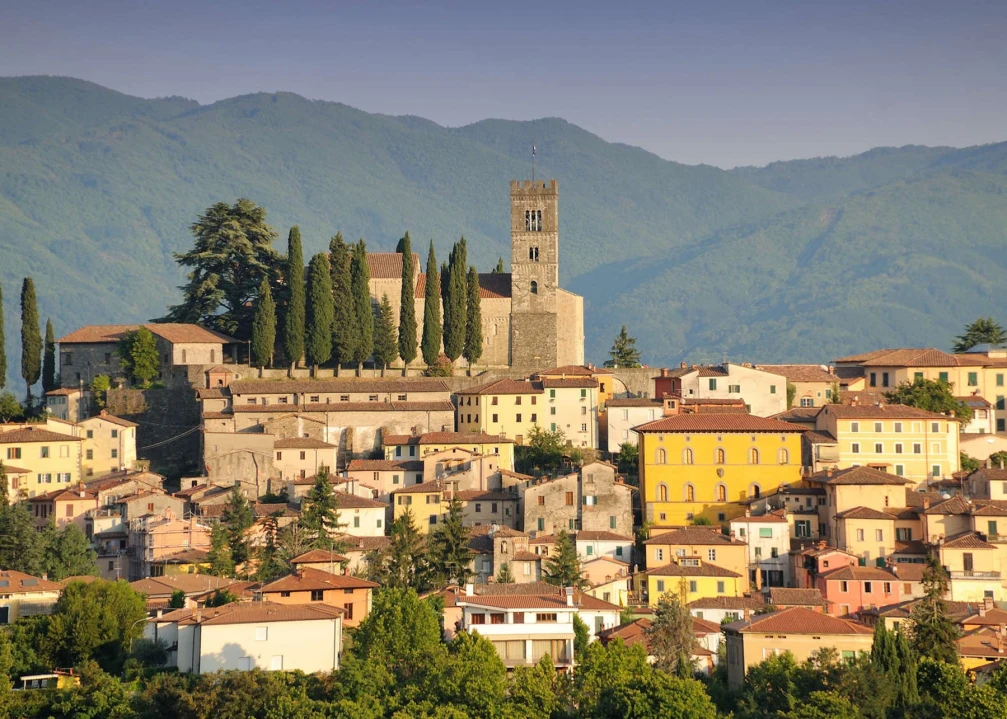The urban structure of Barga has remained more or less that of the time of the Commune (12th-14th cent.), with a tangled network of streets running between the irregular buildings. One enters the village through Porta Reale and Via del Pretorio, crossed by narrow lanes and cart-roads. Past the first square is the Conservatorio di Sant’Elisabetta, an old convent of the Poor Clares (15th cent.), which holds a beautiful altarpiece by the Della Robbia school (15th-16th cent.) and 15th-century Crucifix.
Immediately after we come to the highest part of the castle, dominated by the imposing bulk of the Duomo, or cathedral; from here the view passes over the roofs of the historic center and beyond the green hills dotted with villages and farmhouse to the Apuan mountains.
The main façade of the Romanesque Duomo, built in several stages from the 11th to the 16th centuries using blocks of light-colored alberese (a local limestone that changes color and nuance depending on weather conditions), is the old remodeled side of the primitive church built in the year 1000. The main door is embellished with two slender columns with projecting lions at the top. The arch is decorated with stylized acanthus leaves.
Remaining from the original church are the beautiful holy water stoups (12th or 13th cent.) and the fragment of a fresco. The baptismal font is hexagonal and has a statue of St. John the Baptist (14th or 15th cent.). The ambo is an excellent example of the work of the Comacine master builders and stonecutters. There is a polychrome wooden statue of the town’s patron, St. Christopher, behind the high altar. The chapel on the right is entirely occupied by Della Robbia terracottas, and in the chapel on the left the Barga of the 1500s can be seen in a 16th-century panel.
The name Arringo given to the large yard surrounding the Duomo preserves the memory of the assemblies held by the medieval community. The space is closed off to the north by Palazzo Pretorio, which was the residence of the Florentine administrator from 1341 to 1859, and today is the home of the Civic Museum. From the square by the Duomo there are broad stairs going down to the Church of the Santissimo Crocefisso, with a late 16th-century façade and an interior decorated with stuccoes and gold.
From Via della Speranza one descends to the other city gate, called Porta Macchiaia because it opens onto the great stretches of macchia, or thicket, and the Apennine woods. From there one follows Via di Mezzo, passing alongside old buildings, until arriving at Piazza Garibaldi, which is dominated by the majestic Palazzo Balduini (15th cent.).
At Piazza Salvi there are two buildings in the Florentine style of the 1500s: the Loggia dei Mercanti and Palazzo Pancrazi, today the town hall.
The Loggia, raised on graceful columns, was built when Cosimo I de’ Medici instituted the Barga market (1546), the major commodities of which were salt and silk. The stone lion on the façade is the symbol of Barga’s political subjection to Florence.
Next is Piazza Angelio, whose harmonious proportions make it seem like an outdoor living room. Farther on there is the Teatro dei Differenti, built in 1795 over an earlier theater from 1689, followed by the Accademia dei Differenti, promoted and supported by the Medici. Built along Via di Mezzo are the 18th-century residences of the noble families, including those of the Bertacchi, the Pieracchi counts, and the Mordini. The Baroque Church of the Santissima Annunziata (1595) has a Latin-cross plan, with a vast longitudinal nave and false columns against the walls.
Outside the center, the Church of San Francesco (15th cent.) has glazed terracottas attributed to the workshop of Andrea Della Robbia (1453-1525).
The name
The name’s etymology remains uncertain. According to some it comes from Lucio Barcolio, a lucumon from Luni. Proof of this is supposedly found in Etruscan funerary urns discovered in the mountains surrounding the old castle, from which it is also deduced that the earliest inhabitants were Ligurian-Apuans. Others claim that the name Barga comes from Bargena, a city in Tunisia, whose people came to Italy following Hannibal, 200 years before Christ, and are believed to have settled here.
The product
The chestnut, to which Giovanni Pascoli dedicated a poem, recalling how in the poor houses of the peasants one would hear the pot burbling over the fire: the chestnut provided men with food and animals with a warm bed of leaves.
The recipe
Minestrone made with spelt, a cereal widely used in olden times and lately rediscovered by Tuscan “nouvelle cuisine”. By now every restaurant serving local cuisine offers this popular and hearty “poor man’s” dish.




